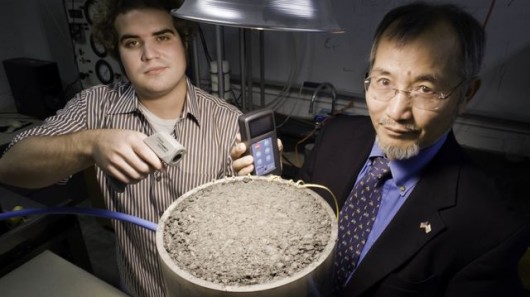
University of Rhode Island graduate student Andrew Correia (left) and Prof. K. Wayne Lee, measuring the solar energy generated by a patch of asphalt
Walk barefoot on an asphalt road and you'll soon realize how good the substance is at storing solar heat – the heat-storing qualities of roadways has even been put forward as an explanation as to why cities tend to be warmer than surrounding rural areas. Not content to see all that heat going to waste, researchers from the University of Rhode Island (URI) want to put it to use in a system that harvests solar heat from the road to melt ice, heat buildings, or to create electricity.
“We have mile after mile of asphalt pavement around the country, and in the summer it absorbs a great deal of heat, warming the roads up to 140 degrees or more,” said Prof. K. Wayne Lee, leader of the URI project. “If we can harvest that heat, we can use it for our daily use, save on fossil fuels, and reduce global warming.”
The research team has four main ideas for how that harvesting could be performed.
Cells on barriers
A relatively simple method of harnessing the sunlight shining on the road, if not the heat stored in it, is to wrap flexible photovoltaic cells around the top of the Jersey barriers on divided highways (Jersey barriers are those long rectangular concrete slabs). These cells could also be embedded in the asphalt between the barriers and the adjacent rumble strips. The electricity generated by the cells could be used to power streetlights and illuminate road signs.
Water pipes in the road
Another approach would be to install water-containing pipes within the asphalt. As the road heated up, so would the water, which could then be piped underneath a bridge deck to reduce icing, used to heat or provide hot water for nearby buildings, or even turned to steam at a power plant. URI grad student Andrew Correia has created a prototype for such a system, which he hopes will demonstrate how it could actually work in the real world.
Thermo-electricity
A small amount of electricity can be created by connecting two semiconductors to form a circuit linking a hot and a cold area. If those semiconductors were embedded in the road at different depths, or in sunny and shady areas, then the difference in temperature between them could conceivably be used to generate electricity. If enough of them were used together, their electrical output could be used for purposes such as defrosting roadways. URI’s Prof. Sze Yang proposes that instead of traditional semiconductors, inexpensive plastic sheet organic polymeric semiconductors could be used.
Electronic block roadways
In what the researchers admit would be the most costly option, asphalt roads could be replaced with roads made from clear-yet-durable electronic blocks. These would contain photovoltaic cells, LED lights and sensors, and could generate electricity, display changeable lane markings, and display illuminated warning messages. Idaho’s Solar Roadways has been working on just such a system, although according to Lee, a driveway made with the blocks cost US$100,000 to create. He believes that such technology may first show up in corporate parking lots, before decreased costs allow it to be used for public roads.
Copyright © gizmag 2003 - 2010 To subscribe or visit go to: http://www.gizmag.com